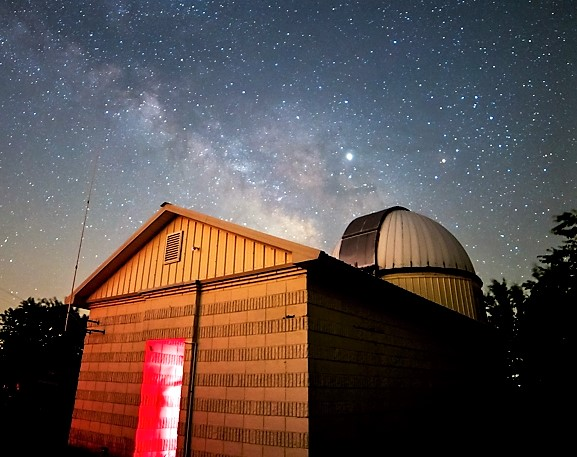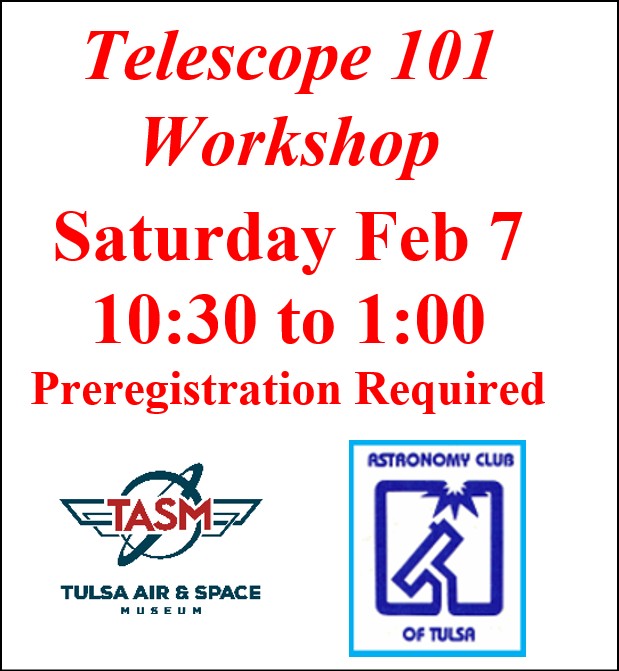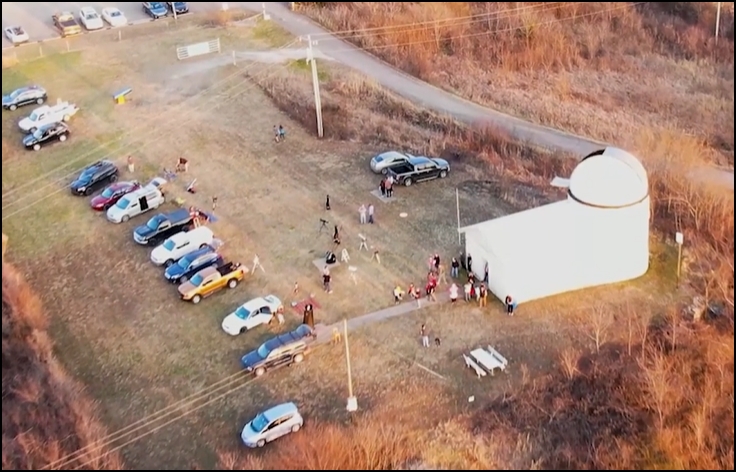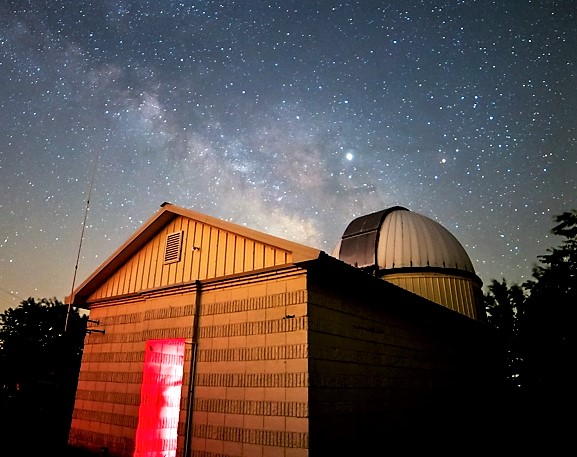Telescopes
Mr. Land has taught astronomy for over 20 years at Broken Arrow Senior High School in Broken Arrow, OK and is an active amateur astronomer with the Astronomy Club of Tulsa.
So you have a NEW TELESCOPE!! What a wonderful instrument for viewing the wonders of God's universe. Most of the members of the Astronomy Club of Tulsa have shared your eagerness to venture forth into the cosmos. The sky is filled with many marvelous wonders but unfortunately there are no flashing signs to tell you where to point your telescope. We would like to share with you some of the lessons we have learned to help you enjoy the magnificence of the night sky.
LEARN THE NIGHT SKY The first step is to learn to name and locate the brightest stars and major constellations. Just as you need a road map to set off on a trip to unfamiliar places on earth, so a good star chart can be you guide through the night sky. There are many good books available which include star charts. I suggest a simple one to start with and then move up to more detailed charts later.
CONSTELLATIONS are official arrangements of stars that have been named for persons, animals or objects. Most of their names have roots in the mythology of the Greeks and Romans. Today astronomers have selected 88 official constellations. These map out the sky much like the boundaries of nations map out the world. You probably know some constellation names; Orion, Gemini, Leo. If you want to search for M42 the great Orion nebula, then you must know how to find Orion.
ASTERISMS are simple patterns of stars with popular names. The BIG DIPPER is an asterism made of the seven brightest stars in a much larger constellation know as URSA MAJOR, the great bear. It has many other names. In England it is a PLOW, in Germany a WAGON and it was known as the DRINKING GOURD among southern slaves.
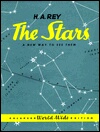
The Stars
One of the best books for learning the Constellations is "The Stars, a New Way to See Them" by H.A. Rey. Rey, the author of the "Curious George" books, presents the constellations in easy to learn stick figure images that resemble the characters for which the constellations are named. See details for ordering the book in the resource section at the end of this page.
DARK ADAPTATION Our eyes take TIME TO ADJUST to the dark. You must plan to stay in a dark area for AT LEAST 10 MINUTES or more to become dark adapted. Avoid going in and out of lighted areas. Try to find an observing site shielded from direct views of street lights or other bright lights. Astronomers use a RED FLASHLIGHT to preserve their dark adaptation when they need to read at night. You can make your own by putting two layers of red cellophane or plastic over an ordinary flashlight. New Observers are sometimes disappointed that they do not see brightly colored images in their telescope like the ones they see in books. The reason is that our eyes can not see color at low light levels. In the daytime our eyes depend on about 6 million CONE cells to see colors. However at night the cones do not have enough light to detect colors. At night our eyes depend on about 25 million ROD cells. The ROD cells only detect different levels of light intensity so that even though you can see detect very faint objects you can not see them in color. If you look carefully you will be astonished at the tiny details you can see and soon will not miss the color.
BRIGHTEST STARS The quickest way to find your way around the sky is to learn the names and locations of the 20 brightest stars. The visible stars are divided into SIX groups based on their brightness. The MAGNITUDE of a star is a numerical measurement of its brightness. The 20 brightest stars are called 1st magnitude. The 2nd magnitude group includes about a hundred stars. Magnitudes 3, 4, 5 etc., become increasingly dimmer.
On a dark country night the dimmest stars visible to the human eye are around 6th magnitude. A 6th mag star is 100X dimmer than a 1st mag star. Its easy to think of star magnitudes like a race. It is better to come in 2nd place than 6th place. A few objects are much brighter than the stars so they are given negative magnitudes. The planet VENUS reaches magnitude -4.4, or 144 times brighter than a 1st magnitude star!! Your telescope however will allow you to see many thousands of stars too dim to be seen by the eye. A typical 60 mm telescope will allow you to see to stars as dim as 10.6 magnitude or 73 times dimmer than your eyes alone.
WHAT CAN I SEE WITH MY TELESCOPE?

MOON The Moon is best observed 3 days either side of 1st or 3rd Quarter. This is when the shadows of objects show the best details. Enjoy low magnification views of the whole moon. Increase to higher magnification to look at the craters and mountains. Look along the TERMINATOR shadow line for bright mountains above the dark shadow.
PLANETS Venus, Jupiter and Saturn are usually grand sights. Mars is also good when at its brightest.

Venus
the brightest planet, often displays bright phases like the moon.

Saturn
is always a rewarding sight. You can see its 4 brightest moons and track their motions from night to night. You can also see two or more bands of clouds on its surface. If you're lucky you can see a shadow of a moon crossing Jupiter during an eclipse. The red spot looks like a small brown oval but is hard to find.

Jupiter
is a big hit with its rings visible with powers of 30X or more, but 100x is better. Look for some of its brighter moons near the rings.

Mars
is brightest every 2 years when closest to the Earth. 100X may reveal its polar caps and some dark surface features.
You can see all the planets except Pluto in a small telescope but they are only tiny balls of light and you must know where to look.
OTHER SOLAR SYSTEM OBJECTS

COMETS
Several comets each year can be seen in a telescope. Current magazines will help you know when and where to look for them.

STAR CLUSTERS
There are many tight groupings of stars containing a few dozen to several thousand stars.

NEBULAE
Fuzzy clouds of glowing gases that look like faint smoke patches often sprinkled with new born stars.

GALAXIES
Spheres or Spirals of billions of stars, gases and dust located great distances away.
These are some of the marvelous sights hidden in the deep shadows of the night. It will be rewarding to learn how to use a star map so that you can find these treasures of the deep night sky with your telescope.
LEARN THE BASIC PARTS AND OPERATION OF YOUR TELESCOPE.
A telescope is an instrument to collect and focus light. The OBJECTIVE is the part of a telescope that gathers and focuses light. The objective many be a set of lenses, mirrors or a combination of both. The SIZE of a telescope is defined by the diameter of its objective. Astronomers often use the word APERTURE to describe its diameter. If someone tells you they own a 6 inch telescope, they mean that its lens or mirrors are 6 inches across. Most department store telescopes are 60 mm (2.25 inch) across.
THREE PERFORMANCE CRITERIA OF A TELESCOPE.
There are three ways to determine how well a telescope performs.
1. LIGHT GRASP
2. RESOLUTION
3. MAGNIFICATION
The DIAMETER of the OBJECTIVE (Aperture) is the most important factor in judging how well a telescope will perform in each criteria. THE LARGER THE OBJECTIVE THE BETTER ITS PERFORMANCE.
The general rule is buy the largest telescope you can afford for you budget! But first decide what you want to do with the telescope before you buy one. You may want to spend money on a special mounting if you plan to take pictures with the telescope.
LIGHT GRASP is the amount of light that is collected and focused by the telescope. Astronomers often use the slang term "Light Bucket" to refer to their telescopes. You can imagine starlight as a gentle "rain" of photons sprinkling down from the heavens above. The LARGER THE OBJECTIVE the BETTER THE MORE ITS LIGHT GRASP.
The formula for Light Grasp is the famous area of a circle:

If you double the diameter of a telescope its light grasp increases by 22 or four times more. Three times = 32 or nine times more etc.
LIMITING MAGNITUDE is the dimmest object visible with that telescope. Your eyes can see objects as dim as 6th mag while a 60 mm telescope can see as dim as 10.6 mag.
RESOLUTION is the ability to see fine details or to separate images of closely spaced stars. Resolution is measured by the smallest angle between two objects so that they still appear as separate objects. In astronomy we use the ARCSEC to measure these angles. One ARCSEC is 1/3600 of a degree. The moon is about 1800 arcsecs width. Your eye can see objects as close as 60 arcsecs. A 60 mm telescope will allow you to see down to 3.2 arcsecs or 20 times more detail.
Again the LARGER THE OBJECTIVE THE BETTER ITS RESOLUTION.
MAGNIFICATION the number of times larger or nearer an object appears. Magnification is MUCH OVERRATED. The MAXIMUM USEFUL MAGNIFICATION of a telescope is limited to 50 power per inch of diameter or 2 power per millimeter. Thus a 60 mm telescope can magnify ONLY up to 120 POWER. Any attempt to push a telescope beyond this limit will result in a fussy disappointing image. As you can see from the above picture, increasing the magnification doesn't always allow you to see more details. Many department store telescope advertise power far beyond what they can deliver. This doesn't mean than they are bad telescopes as long as they are used within their performance limits.
LIGHT GRASP and RESOLUTION cannot be changed without buying a different telescope. Magnification ,however, can be selected for the type of object you wish to view.
Use LOW POWER - 30X to 50X to find you target and view star clusters or larger objects. Also great for bird watching if you don't mind the upside down images.
Use MEDIUM POWER - 80X to 100X for the moon, planets, star clusters, nebulae and galaxies.
Use HIGH POWER - 150X or more for specific details of planets and moon craters.
CALCULATING MAGNIFICATION Most telescopes come with 2 or 3 different eyepieces to change the magnification. To find the magnification of a eyepiece, divide the eyepiece focal length into the telescope focal length. The focal length of eyepieces and telescopes are often labeled on the telescope or in the owners manual. Focal length is usually close to the actual length of the telescope if it is a simple refractor.

Magnification = Telescope Focal Length = 720 mm = 72 power
Eyepiece Focal Length 10 mm
If your telescope has a 720 mm focal length then an eye piece of 10 mm would give 72 power and 6 mm gives 120 power. Most telescopes come with a BARLOW lenses that doubles the power of each eyepiece so that the 10 mm eyepiece would double to 144X. BUT BEWARE! A 60 mm telescope can ONLY produce magnifications of 120X!!
ATMOSPHERIC LIMITS We observe the stars through a constantly moving ocean of air. The currents in the air blur and distort the images we see. It is a rare night that you can observe with powers over 200x, and Resolution is seldom better than 1 arcsec even with a very large telescope. When the wind is active or the temperatures unstable, 100X may be more than you can use effectively. Light Grasp still gets better with larger telescopes however.
Below is a table showing the performance of some popular sizes of telescopes. (The EYES column refers to Light Grasp compared to the Human eye.)
| Telescope Diameter | Eyes | Magnitude Limit | Resolution (arcsecs) | Smallest Detail Visible on Moon in Miles |
| Eye 7 mm | 1 | 6.0 | 60 | 225 |
| 60 mm | 73 | 10.6 | 3.2 | 10.0 |
| 3 inch | 118 | 11.2 | 1.5 | 5.5 |
| 4.25 inch | 238 | 11.9 | 1.0 | 3.8 |
| 6 inch | 474 | 12.7 | 0.8 | 3.0 |
| 8 inch | 843 | 13.3 | 0.6 | 2.0 |
CARE & CLEANING
Since the objective is the most important part of your telescope take special care to keep it safe from damage and clean. Store your telescope in a safe place where it will not fall over and break. If your telescope has a dust cap keep it on when not in use or tie a clean plastic bag around the objective to keep it clean. NEVER attempt to take the objective lens apart!!. Small specks of dust usually do not affect your seeing. If you must clean the objective use a soft CLEAN camel hair paint brush to whisk away small bits of debris. Finger prints may be removed by a soft cotton ball barely damp with rubbing alcohol. DO NOT RUB the objective!! Follow up by gently dabbing dry with several dry cotton balls. To avoid liquid running between the lenses, point refractor (lenses) telescopes front face straight down when cleaning
For More Information go to HOW TO PICK A TELESCOPE
ADDITIONAL SOURCES OF INFORMATION:
Astronomy Club of Tulsa We meet monthly at the Jenks High School Planetarium plus we also have frequent observing nights at our observatory near Mounds. Oklahoma.
MAGAZINES Astronomy and Sky & Telescope both have information on current astronomy events plus lots of HOW TO articles to learn your telescope.
There are also fascinating articles on many other astronomy topics.BOOKS There are too many to name specifically. Two books I recommend are by H.A. REY the author of "Curious George". Rey represents the constellations with easily recognized patterns that resemble stick figures of the objects for which they are named. These are excellent for introduction to learning constellations and stars.
Find The Constellations ISBN 03952 44188 around $10 for early Elementary Grades. Available at Amazon
The Stars (A new way to see them) ISBN 03952 48302 around $12 You may have to order these but they will be well worth your wait if you are a first time sky learner. Available at Amazon
There are many star maps and computer programs available. Try to start out simple. Avoid buying the "million star" maps until you are confident you can make good use of them.
SOME INTERNET RESOURCES:
Sky & Telescope has many levels of information updated weekly.
Astronomy.com Good resource but rich with ads.
Astronomics in Norman, OK. A large mail order telescope outlet. Has lots of information on selecting a first telescope and reliable service.
Orion Telescopes They have some reasonably priced beginner telescopes as well as many advanced models.
Celestron Meade Two of the world's largest telescope manufacturers.
Astronomical Data Center for Students and Educators
This is the most extensive high quality treasure chest of Astronomical information for students I have located to date. If you can think of it it's probably here or will take you to it!!
Students for the Exploration and Development of Space AWESOME STUFF!!
Space Day Lots of children's activities on Astronomy
Astronomy Picture of the Day This sight has a new picture every day often featuring the latest images. Its short paragraph of information has many links to other sites. It also features a searchable archive of 2000+ images.

